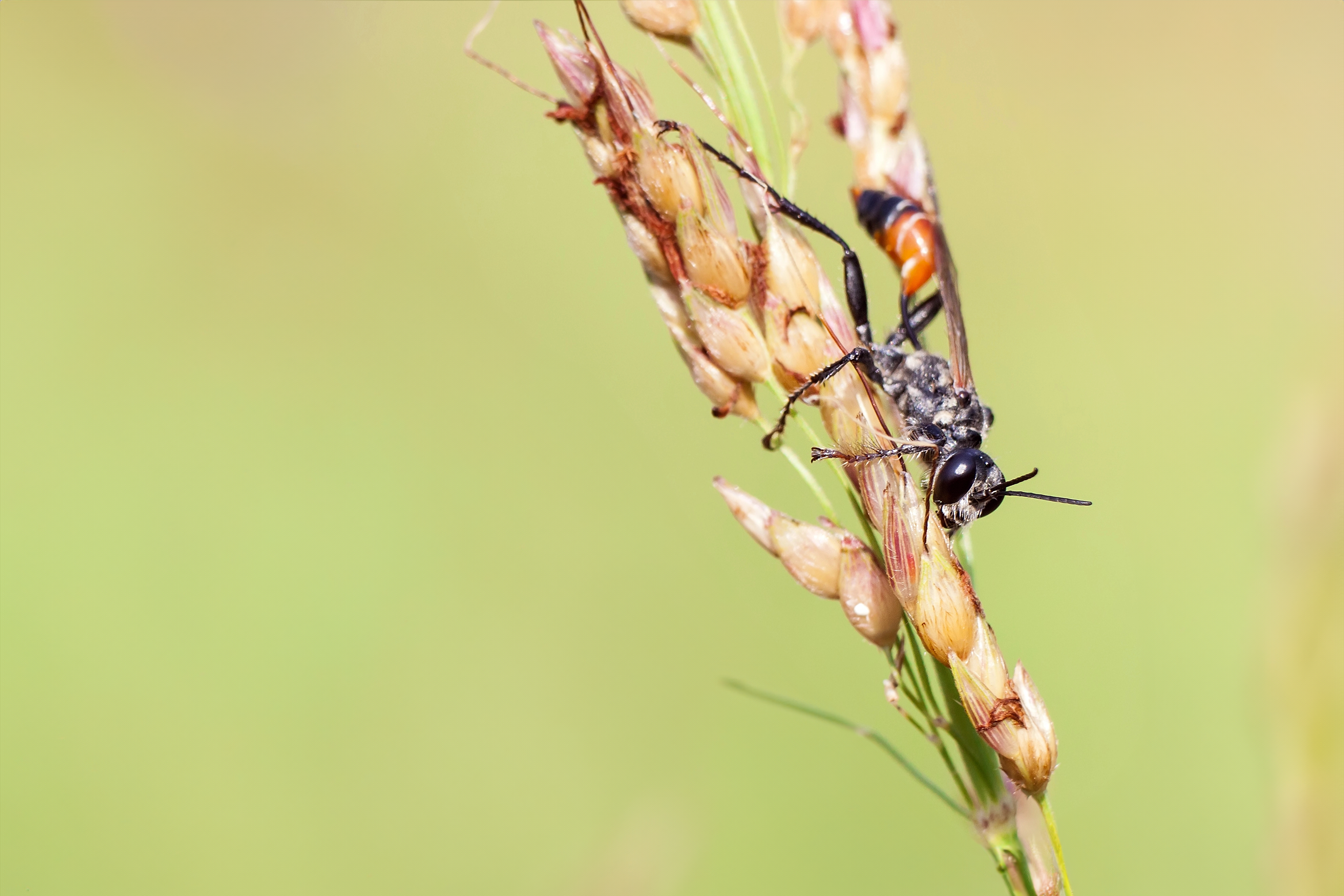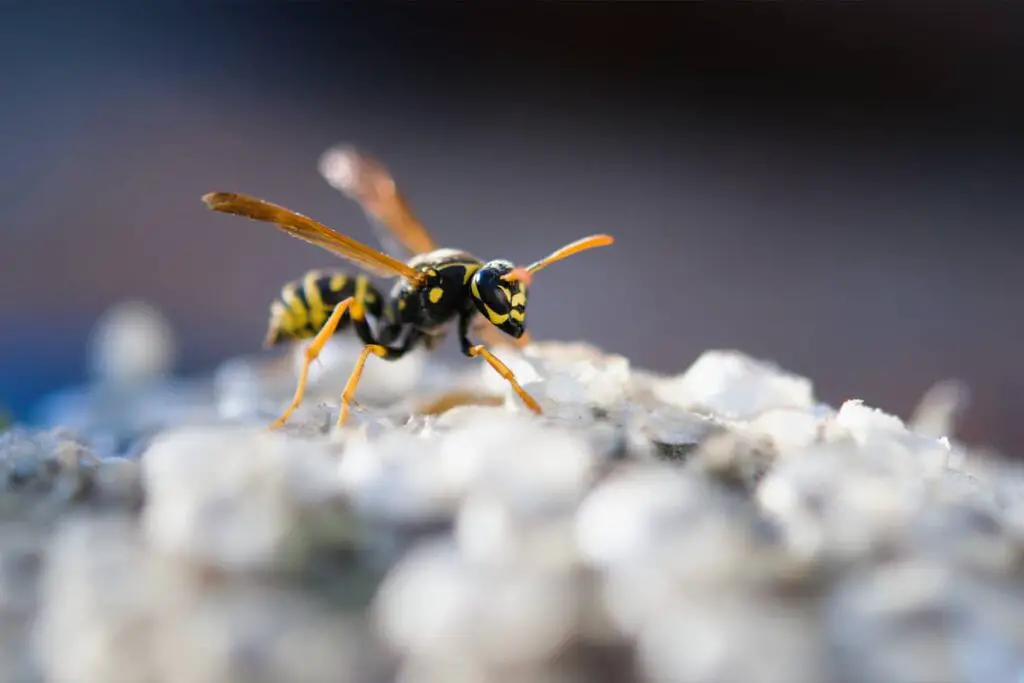
Sand wasps are fascinating creatures with unique dietary preferences that set them apart from other wasps. As predators and valuable parts of the ecosystem, they primarily feed on insects. When you encounter sand wasps in your garden, they’re likely on the hunt for their next meal. Unlike social wasp species that might harass you during a picnic, sand wasps won’t show much interest in your food; they’re after a different kind of bounty.
Understanding what sand wasps eat involves looking at their hunting behaviors and the kind of prey they capture. These wasps are known for their exceptional flying and hunting skills, which allow them to capture various insects mid-flight. They’re particularly partial to flies, which they skillfully snatch out of the air, paralyze with their sting, and bring back to their nests to feed their larvae. This natural pest control helps manage fly populations, making sand wasps beneficial to have around.
Dietary Habits of Sand Wasps
When you encounter sand wasps, you’re looking at insects with quite specific dietary preferences. These wasps have fascinating feeding habits that are both unique and effective in their ecological niche.
Prey Preferences
Sand wasps are carnivorous, mainly preying on flies to nourish their larvae. Adult sand wasps, on the other hand, feed on nectar. Their prey selection often includes house flies, horse flies, and other common flies found in their habitat. This diverse diet makes them natural pest controllers.
Hunting Strategies
To secure meals for their offspring, sand wasps have developed proficient hunting techniques. With keen eyesight, they are capable of capturing flies in mid-air. Once they catch their prey, they paralyze it with their sting before transporting it back to their nest. This ensures a fresh food source for the emerging larvae upon hatching.
Feeding Behavior
When exploring the dietary habits of sand wasps, you’ll uncover a distinct separation between what fuels the larvae and the nourishment chosen by adult wasps. Here’s an in-depth look at each stage’s feeding behaviors.
Larvae Nutrition
Larvae of sand wasps are entirely dependent on their mothers for food. The female wasp stocks the nest with a provision of paralyzed insects or spiders, which ensures that the larvae have a fresh and abundant source of nutrients. This prey is specifically selected to support the growth and development of the young wasps until they’re ready to emerge as adults.
Adult Consumption
Once matured, adult sand wasps shift their diet to primarily include nectar and sap. They play a role in pollination, as they visit various flowers to feed on nectar. By doing so, they inadvertently transfer pollen. However, they can also occasionally prey on insects, but this predatory behavior is largely seen during the earlier stages of their life cycle.
Environmental Impact on Diet
Your local environment plays a critical role in shaping the diet of sand wasps. These insects are opportunistic feeders, and their food choices are largely influenced by the availability of prey in their habitats.
- Abundant Prey: In areas with a high population of small insects, sand wasps may have a diverse diet consisting of various bugs they can overpower.
- Scarcity: During lean times or in poor conditions, sand wasps must adapt, sometimes targeting different or less-preferred prey to ensure survival.
Temperature and Climate: The climate of a region affects insect activity, and thus, the diet of sand wasps. In warmer regions, you might find:
- A larger variety of prey due to increased insect activity.
- More frequent feeding periods as metabolic rates in sand wasps increase with heat.
In contrast, cooler climates can lead to:
- Limited prey, pushing sand wasps to expand their hunting periods or reduce breeding to conserve resources.
- Dependence on specific, cold-tolerant insect species for sustenance.
Vegetation and Cover: The type of flora in an area determines the hiding spots and nesting grounds for both prey and predator. Sand wasps in lush environments might eat:
- More camouflaged or sedentary insects that live among dense plants.
- A different spectrum of species that closely associate with particular flowers or trees.
Human Impact: Urbanization affects sand wasps’ diets by:
- Reducing insect diversity, limiting wasps to the most common urban prey.
- Potentially introducing non-native species that can become new food sources.
Each factor in your local environment interplays to dictate the available food sources for sand wasps, ultimately affecting what these fascinating creatures eat.
Frequently Asked Questions
In this section, you’ll find answers to common questions about sand wasps, including their diet, interaction with humans, and ecological impact.
What do sand wasps typically prey on?
Sand wasps are known to prey on various insects, particularly flies, which they capture and paralyze to feed their larvae.
How can one safely remove a sand wasp nest?
For safe removal of a sand wasp nest, it’s often best to seek professional pest control services as they have the expertise and equipment to do it without harm.
What are the benefits of having sand wasps around?
Sand wasps serve as natural pest controllers, given their hunting of other insects, potentially reducing the population of pests in your garden.
Can sand wasps be harmful to humans?
Generally, sand wasps are not aggressive, and they rarely sting unless provoked or threatened, thus posing minimal risk to humans.
How does the presence of sand wasps affect the local ecosystem?
The presence of sand wasps can benefit the local ecosystem by controlling pest populations and thus maintaining a balance amongst insect species.
What attracts sand wasps to a particular area?
Sand wasps are often drawn to areas with loose, well-drained soil that is suitable for nest building, and an abundance of insects to hunt.
Driven by a passion for those tiny creatures that rule our world, we at Bug Domain strive to be your go-to resource for information on insects.




